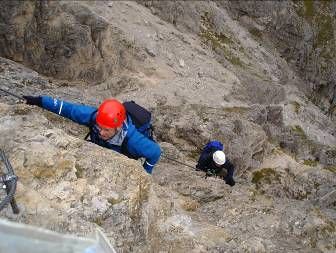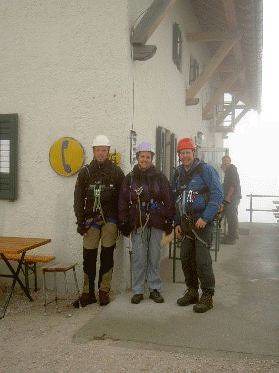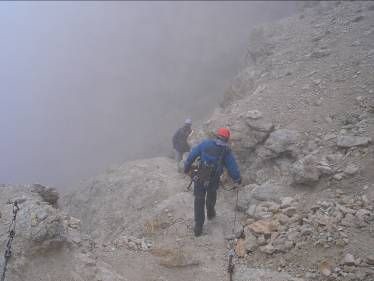Well the “To Do” list got a little shorter this summer. Via Ferrata
(VF) is now among the ever-growing list of things to try to fit in
during the year. Andy Turner and I have wanted to give this a go for
several years, and this year we managed to make it happen. Jo and I
decided to take a walking holiday in the same area and Polly decided
that she’d like to have a go at the VF too.
We choose Val Gardena, better known as a downhill ski resort, as our
base. What an absolute beautiful valley, stunning scenery dominated by
Langkofel (on the right) and the Sella massif.
 |
| The Sella Massif and Langkofel from Ortisei (click on any picture for image in Flickr) |
Our only oversight in planning was drastically under estimating the
travel time from Trevisio airport to our accommodation in Ortisei. Five
hours in rain and hail, in a left-hand drive hire car on Italian
mountain roads, preceded by a 3:00am start for Stanstead meant that we
slept well the first night. So well, in fact, that 10:00am was the
first we saw of the next day.
Leaving Jo to explore the village and to find some cake for our return,
we headed for Passo Gardena. We had decided that an easy warm up would
be a good idea, getting us familiar with the local rock and more
importantly the Kletterstieg kits used to attach each of us to the
fixed iron work. For those that have not tried VF, a Kletterstieg unit
looks a bit like a double cows-tail, connected to your harness via a
KISA (Kinetic Impact Shock Absorber). This is like a self- belay
device, but allows you and the equipment to take lobs with fall factor
greater than two, and live to tell the tail!
DON’T BE TEMPTED TO USE A SIMPLE SLING; THEY ARE LIKELY TO SNAP IF YOU
TAKE TOO MUCH AIR!
With only a 15-minute walk in and a grade of 2A we chose CORV2 for our
first route (See footnote1). On with the harness, add a chest harness
and larks foot on the Klettersteig unit. The first part of the route
was unprotected and the last few moves before the cable started were a
bit tricky in the now damp conditions. The route starts with a short,
slightly overhanging ladder and then moves onto a small arete. The next
section starts with a short step over a narrow gully and our first
introduction to exposure. The route then traverses a buttress
diagonally depositing you onto a wide arete. At this stage the
protection also disappears for a while, until the next vertical pitch
is encountered. This pops out leaving only a short ‘crux’ section
before the summit cross is achieved. Three adults occupy most of the
summit, and after sampling the local ham and cheese, we prepare for the
return trip. The top pitch is a little tricky in reverse but soon we’re
descending a gully back toward the car. For me this was the most
worrying section, dubious anchors and loose rock, my favourite 😉
 |
| Climbing on CORV2 |
The next day we were much better prepared, and up for more of a
challenge. Today we were to attempt Via Ferrata Brigata Tridentina (or
CORV4 in the book), with a book time of 5 to 7 hours. This is a 3B
route, more technical and more serious. You may however sense a theme;
the walk in is only 10 minutes. We kitted up in the car park and
traversed along a path, passing some impressively overhanging bolted
routes before arriving at the start with another group, part of which
were also beginners.
 |
| Looking up the first section of Via Ferrata Brigata Tridentina |
The route splits into two major sections. The first is predominantly on
stemples (steps that look like overgrown staples epoxied into the rock)
moving up then across a fairly steep slab. By this stage the weather
has started to rain, but the rock is proving amazingly sticky for
limestone. After encountering a short ‘traffic jam’, we emerge between
two massive boulders on a very wide ledge. The next climbing is about
15 minutes walk away, and we do our best to put some distance between
ourselves and the other people.
The next section is about 300m of ascent and includes a full gambit of
wire, stemples and ladders. The rain redoubled its efforts but we were
not to be deterred, but were slightly cautious in case the dreaded
lightening made an appearance. The climbing was varied and absorbing,
with some pitches verging on VD. We were tracked by a couple of old
hands one of whom was using a single krab to clip in. (The Klettersteig
units include two krabs so that you can leap frog any anchors, leaving
you with at least one krab connected at all times.) Fortunately /
unfortunately (delete as appropriate) the cloud somewhat truncated the
views, but just occasionally the whole route appeared below, with the
valley floor 600m, or so, below. Exposure by the bucket load.
 |
| Andy on the Bridge |
Style wasn’t high on the agenda and all thoughts of a pure rock bound
ascent were forgotten, wet limestone and walking boots do that for you.
The arms and legs were certainly starting to feel it when at last the
final part of the route appeared: a short suspension bridge surrounded
by cloud and little else. The cloud somewhat spoilt the view, but have
a look in the September 2005 issue of Trail (pg 129) if you want to see
what it should have looked like. The ironwear stopped and 15 minutes
later we are purchasing hot chocolate in the Pisciadu hut. Very welcome
as we all sat there steaming.
Only the descent to go: it was with a bit of trepidation on my part
that we set off to find the route down: a 650m gully. As it turned out
the descent was pretty good. The steep upper section was well
protected. Although many of the Europeans weren’t bothering to use the
ironwork, they did go very quite at the crux! The protection stopped
just as the angle eased a little, and whilst there was a lot of scree
to descend, the path was fairly good (although apparently it can be
vague early in the season).
 |
| Andy, Polly and Mark preparing to descend from the Pisciadu hut |
What a superb day: great climbing, good company, but shame about the
views. This route has something for everyone. In fact you could go one
better and combine this route with the complete traverse of the Sella
massif, next time perhaps.
 |
| Descending on Via Ferrata Brigata Tridentina |
If you’ve been thinking of giving Via Ferrata a go, then do it, it’s
superb fun. There are plenty of cheap flights to that part of Italy,
but don’t underestimate the travel time on the Italian roads. Whilst on
suggestions, if you have a go yourself we all recommend the Salewa
Klettersteig kit, the special karabiners are so much easier to use than
twist lock and safer than simple snap gates. You’ll appreciate this
most of all when the climbing gets tricky. Also make sure you get some
suitable gloves, the cable does get frayed and is pretty sharp.
